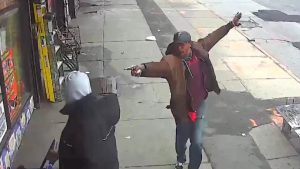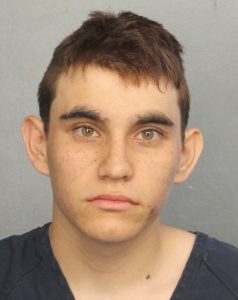
By Gina Cherelus
NEW YORK (Reuters) – The New York State attorney general’s office said on Thursday it would investigate the fatal shooting by police of an unarmed black man in Brooklyn after he pointed a metal pipe at officers that they believed was a gun.

Saheed Vassell points a metal pipe at a pedestrian in Brooklyn April 4, 2018, in a still image from surveillance video released by the New York Police Department in New York City, New York, U.S. on April 5, 2018. NYPD/Handout via REUTERS
“We’re committed to conducting an independent, comprehensive and fair investigation,” Amy Spitalnick, a spokeswoman for New York Attorney General Eric Schneiderman, said in a statement.
The death of Saheed Vassell on Wednesday was the latest fatal shooting of an unarmed black man by police, fueling more protests and heightening a nationwide debate over the use of excessive force by police and accusations of racial bias in the criminal justice system.
More than 200 demonstrators and activists took to the streets of the Crown Heights neighborhood in which Vassell was shot, chanting “Justice for Saheed.”
“They murdered my son and I want justice for him,” Lorna Vassell, his mother, said at the protest.
The family has demanded a coroner’s inquest.
Police said Vassell was killed by officers responding to reports of a man aiming a gun at pedestrians. When the officers arrived, police said, Vassell took a two-handed shooting stance and pointed an object at them.
The officers believed the suspect was holding a firearm, a senior police official told a news conference on Wednesday, and three plainclothes officers and one uniformed officer fired 10 shots. Vassell died in a hospital.

Saheed Vassell points a metal pipe before being shot to death by police in Brooklyn April 4, 2018, in a still image from surveillance video released by the New York Police Department in New York City, New York, U.S. on April 5, 2018. NYPD/Handout via REUTERS
Police on Thursday released security camera footage that showed Vassell approaching people on the street and pointing the pipe at them as if it were a pistol. They also released partial transcripts of three 911 emergency calls.
“There’s a guy walking around the street, he looks like he’s crazy but he’s pointing something at people that looks like a gun and he’s pulling the trigger,” one of the callers said.
Local media reported that Vassell was 34 years old, suffered from mental illness, and was well known in parts of Crown Heights.
His killing followed the fatal shooting by police of an unarmed black man, Stephon Clark, 22, in Sacramento, California, that has sparked more than two weeks of demonstrations.
Officers responding to a report of someone breaking windows killed Clark on March 18 in his grandmother’s backyard. The officers feared he had a gun, but it turned out he was holding a cellphone, Sacramento police said.
(Reporting by Gina Cherelus in New York; Additional reporting by Bernie Woodall in Fort Lauderdale, Florida; Editing by Daniel Wallis, Bill Trott, Tom Brown)



